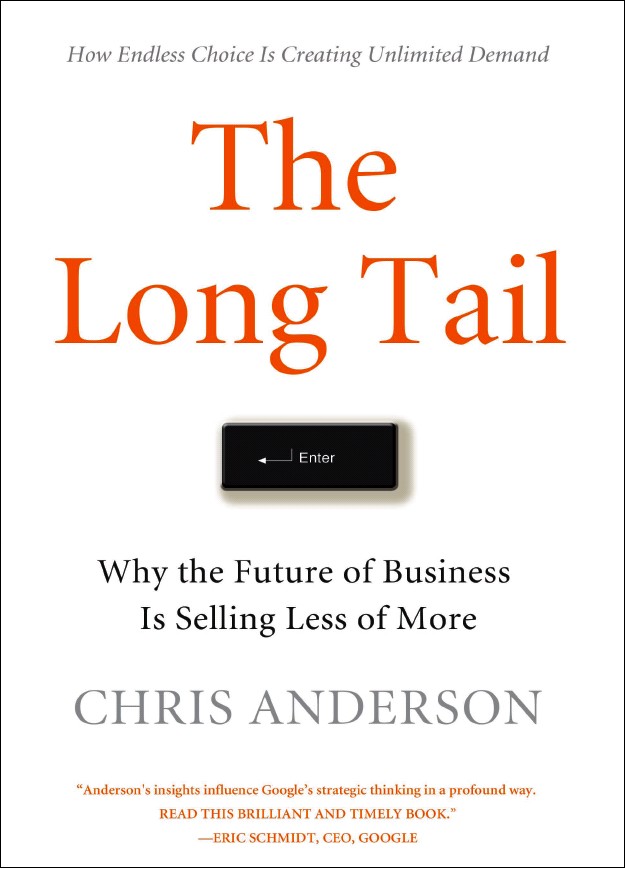A Review: Long Tail in the House!
I’d started reading The Long Tail (You’ve read the blog, now buy the book!) by surprising myself with how excited I was to read the book; After all, I’d read the original article in Wired when it came out, and have been following Chris’ blog since it started. Was there really anything new left? How could I still be interested in a topic that long ago became part of the scenery for the Web 2.0 and VC crowd?
In short, it’s just plain good writing. My enjoyment of the book probably centers around the extensive amount of hard data used to gird the book’s examples, as well as the pleasingly broad set of cultural influences and examples used to illustrate the effects of the Long Tail. I’ve criticized the technology industry often for its unrepentant insularity; The breadth of culture in The Long Tail amply evidences the fact that the phenomenon extends well past the confines of the traditional definition of “technology” as an industry.
Above all else, using a wider range of source material than even the seminal Wired article, along with the phenomenal amount of primary research into sales data, makes the book something very impressive and unique. The Long Tail is profoundly intellectually honest.
I’m on the record as a genuine admirer of Malcolm Gladwell, but I have to say that one of the most accurate of the persistent criticisms of his work is that it often substitutes qualitative anecdotes for qualitative evidence. Given that this is, to some degree, what Blink is about, I don’t find this a particularly egregious habit. But it is nevertheless a valid point to raise, and The Long Tail is a stronger book for the near-scientific rigor of much of its analysis. (Informing this discipline, no doubt, is Chris’s stints at Nature and Science.)
But here’s an example of how the breadth of the narrative really got my gears turning. If you read this site back when I used to do my Daily Links, you might remember the history of house music I linked to. It’s an encyclopedic and comprehensive resource that, along with the dictionary of samples, was one of my favorite links ever. Interestingly, house music comes up near the end of The Long Tail.
Now, I believe that, without hip hop and remix culture (of which house music is firmly a part), there would be no blogging. “Rip, Mix, and Burn” isn’t merely a tenet of digital culture, it’s among the fundamental principles of post-disco black music, which has consistently shaped contemporary culture. And that’s important to note because The Long Tail isn’t a book about business, or the Internet, or even economics. At least, it isn’t merely about economics; It’s a book about a change in culture.
Of course, The Tipping Point reached its, well… you know, after somehow morphing from being a book about cultural trends into being perceived as a business guide. So I’m not surprised that The Long Tail is packaged that way; The same audience might well purchase it for the same reasons. Indeed, Reed Hastings‘ back-cover blurb suggests that The Long Tail will sit on your shelf between The Tipping Point and Freakonomics. Presumably these books are all also bad and good for you.
But I digress. House music, you say? Let’s go to the tape:
What was notable about the rise of house was that it was both a reaction to the bankruptcy of blockbuster culture and a vibrant culture of its own. DJs and clubs created a music industry that was radically different from pop music. Clubbing is really about surfing the Long Tail of dance music, and this ecosystem has seen the evolution of new models of innovation around it.
Naturally, there’s a lengthier explanation of why this is so in the book, along with an acknowledgement of Umair Haque for contributions to the analysis. But what struck me as noteworthy in this, admittedly minor, part of the book was the pleasantly catholic set of influences. There’s a lot of commonalities between the various long tail-based media that media hackers and culture jammers tend to gravitate towards.
I think it’s no coincidence that many early bloggers (and, especially, many people who made blog-related tools) have been influenced by hip hop’s remix culture, or by the multifaceted beat-matching culture of DJing. It’s not just the methods of distribution that are similar; It’s the aesthetic of mix-and-match, more lately referred to as Rip, Mix, and Burn.
Have I mentioned that, in addition to being an early investor in Six Apart and a skilled blogger, Joi Ito used to be a house DJ in Chicago? It’s true.
